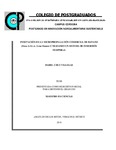| dc.contributor.author | Cruz Villegas, Isabel | |
| dc.creator | CRUZ VILLEGAS, ISABEL; 786513 | |
| dc.date.accessioned | 2019-05-28T14:25:39Z | |
| dc.date.available | 2019-05-28T14:25:39Z | |
| dc.date.issued | 2018-07 | |
| dc.identifier.uri | http://hdl.handle.net/10521/3303 | |
| dc.description | Tesis (Maestría en Ciencias, especialista en Innovación Agroalimentaria Sustentable).- Colegio de Postgraduados, 2018. | es_MX |
| dc.description.abstract | Los Sistemas de Inmersión Temporal (SIT) son la mejor alternativa para micropropagación comercial de plantas. Sin embargo, aunque se han reportado éxitos con los SIT, se requiere validar el sistema más adecuado para la multiplicación de banano in vitro. El objetivo de esta investigación fue comparar la eficiencia de diferentes SIT para micropropagación de banano (Musa AAA cv. Gran Enano), respecto a los sistemas convencionales (inmersión parcial y semisólido). Se utilizaron los sistemas biorreactores de inmersión temporal, biorreactor de inmersión por gravedad, MATIS y SETIS. Además, se evaluó el medio líquido con inmersión parcial y cultivo en medio semisólido. A los 28 días de cultivo, se evaluó el número y longitud del brote, el número de hojas por brotes, el contenido de clorofila, el índice estomático y el porcentaje de estomas cerrados. Además, el porcentaje de supervivencia y el desarrollo ex vitro de las plantas fueron evaluados durante la aclimatación. Los resultados mostraron que los SIT tienen una mayor tasa de multiplicación respecto a la inmersión parcial y el medio semisólido. El contenido de clorofila, el índice estomático y los estomas cerrados son afectados por los diferentes sistemas de cultivo. Los diferentes sistemas de cultivo no tienen efecto sobre el porcentaje de supervivencia; sin embargo, se observaron diferencias durante los parámetros morfológicos ex vitro en la aclimatación. En conclusión, en este estudio el biorreator SETIS resultó el sistema de cultivo más eficiente para la micropropagación comercial de banano. _______________ INNOVATION IN THE COMMERCIAL MICROPROPAGATION OF BANANO (Musa AAA cv. Grand Naine) USING A TEMPORARY IMMERSION SYSTEM. ABSTRACT: Temporary Immersion Systems (TIS) are the best alternative for commercial micropropagation. However, although successes have been reported with TIS, it is necessary to establish the most suitable system for in vitro banana multiplication. The aim of this research was to compare the efficiency of different TIS for banana (Musa AAA cv. Grand Naine) micropropagation. The temporary immersion bioreactor, gravity immersion bioreactor, MATIS and SETIS bioreactor systems were used. In addition, liquid medium with partial immersion and semi-solid medium culture were evaluated. At 28 days of culture the number and length of shoots, number of leaves per shoot, chlorophyll content, stomatal index and percentage of closed stomata were recorded. Additionally, survival percentage and ex vitro development of the seedlings were evaluated during acclimatization. Results showed that TIS have a higher multiplication rate with respect to partial immersion and semi-solid medium. The chlorophyll contents, stomatal index and stomata functioning are affected by the different culture systems. The different culture systems had no effect on survival percentage; however, morphological differences were observed during acclimatization. The SETIS bioreactor was more efficient than the rest of the TIS, producing better development in the plants obtained in vitro and ex vitro, proving it to be a useful alternative for banana micropropagation. | es_MX |
| dc.description.sponsorship | Consejo Nacional de Ciencia y Tecnología (CONACyT). | es_MX |
| dc.format | pdf | es_MX |
| dc.language.iso | spa | es_MX |
| dc.rights.uri | http://creativecommons.org/licenses/by-nc-nd/4.0 | es_MX |
| dc.subject | Inmersión temporal | es_MX |
| dc.subject | Clorofila | es_MX |
| dc.subject | Estomas | es_MX |
| dc.subject | Aclimatización | es_MX |
| dc.subject | Temporary immersion systems | es_MX |
| dc.subject | Chlorophyll | es_MX |
| dc.subject | Stomata | es_MX |
| dc.subject | Acclimatization | es_MX |
| dc.subject | Innovación Agroalimentaria Sustentable | es_MX |
| dc.subject | Maestría | es_MX |
| dc.subject.classification | INGENIERÍA Y TECNOLOGÍA::CIENCIAS TECNOLÓGICAS::TECNOLOGÍA DE LOS ALIMENTOS::VALOR NUTRITIVO | es_MX |
| dc.title | Innovación en la micropropagación comercial de banano (Musa AAA cv. Gran Enano) utilizando un sistema de inmersión temporal. | es_MX |
| dc.type | Tesis | es_MX |
| Tesis.contributor.advisor | Bello-Bello, Jericó Jabín | |
| Tesis.contributor.advisor | Morales Ramos, Victorino | |
| Tesis.contributor.advisor | Caamal Velázquez, José Humberto | |
| Tesis.contributor.advisor | García Ramos, Juan Carlos | |
| Tesis.date.submitted | 2018-07 | |
| Tesis.date.accesioned | 2019 | |
| Tesis.date.available | 2019 | |
| Tesis.format.mimetype | pdf | es_MX |
| Tesis.format.extent | 1,546 KB | es_MX |
| Tesis.subject.nal | Micropropagación | es_MX |
| Tesis.subject.nal | Micropropagation | es_MX |
| Tesis.subject.nal | Bananos | es_MX |
| Tesis.subject.nal | Bananas | es_MX |
| Tesis.subject.nal | Musa | es_MX |
| Tesis.subject.nal | Cultivo in vitro | es_MX |
| Tesis.subject.nal | In vitro culture | es_MX |
| Tesis.subject.nal | Biorreactores | es_MX |
| Tesis.subject.nal | Bioreactors | es_MX |
| Tesis.subject.nal | Biotecnología agrícola | es_MX |
| Tesis.subject.nal | Agricultural biotechnology | es_MX |
| Tesis.subject.nal | Amatlán de los Reyes, Veracruz, México | es_MX |
| Tesis.rights | Acceso abierto | es_MX |
| Articulos.subject.classification | Innovaciones tecnológicas | es_MX |
| dc.type.conacyt | masterThesis | es_MX |
| dc.identificator | 7||33||3309||320609 | es_MX |
| dc.contributor.director | BELLO BELLO, JERICO JABIN; 203316 | |
| dc.audience | generalPublic | es_MX |


